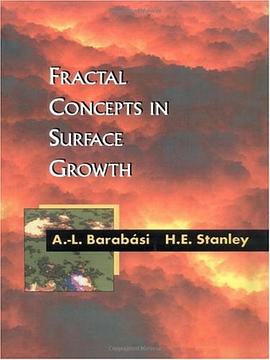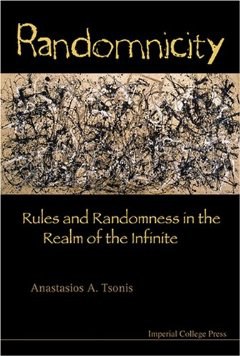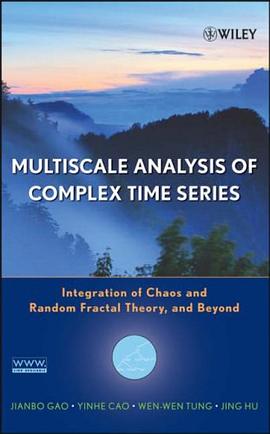

具體描述
本書是國內也是國際第一本分形幾何在流體中的應用的參考書。本書介紹的方法不僅可以用於流體, 還可以用於其他任何有關連續隨機的運動軌跡的模擬,用於粒子雲的隨機散布軌跡。
本書是瞿波博士在英國的博士學位論文的核心成果。書中深入淺齣地介紹瞭分形及其在流體中的應用。詳細論述瞭如何用分形中的分數布朗運動(fBm)模擬流水中汙染物的軌跡,包括對海灣和海洋中的汙染物傳播軌跡的模擬。
書中介紹的方法是基於分數布朗運動(fBm), 這是帶有記憶的著名的布朗運動(隨機散步)的推廣。 作者對著名的fBm作瞭改進,創建瞭分數布朗運動粒子跟蹤模型,並推廣到加速分數布朗運動粒子跟蹤模型。基於豪斯特指數(H)的靈活性,分數布朗運動粒子追蹤模型的應用非常廣泛。可以用於經融、股市、腦電圖、岩石的裂縫,道路的分布、海洋的浮標軌跡、粒子的散布、醫學上人體肺的分布及毛細胞血管、腦電圖麯綫(圖14)等具有分形的特徵物體和現象中。
本書的第一部分介紹瞭分形。不同於其他書介紹分形時所用的復雜的數學工具,使人望而生畏,書中介紹的分形及分形維數的計算都是用最通俗易懂的方法。這是一本實用性強、淺顯易懂的應用數學學習和研究參考用書。書中還附有程序供直接使用。相信此書對大學生、研究生、大學青年教師搞科研有一定的實用和參考價值。
著者簡介
瞿波 博士
江蘇南通人。
1983年華東師範大學數學學士。
1986年華東師範大學數學碩士。
1992年赴英國在愛丁堡龍比亞大學(Edingburgh, Napier University)攻讀計算機碩士課程和流體力學博士學位。研究方嚮是分形在流體中的應用。1999年獲英國博士學位(PhD degree)。
1999年英國貝爾法斯特女王大學(Queen’s University of Belfast)研究助理。
2000年香港大學(Hong Kong University)土木工程係博士後。
2003年澳大利亞格裏菲裏斯大學(Griffith University)研究員。
2008年迴國,在南通大學任教。碩士生導師。承擔國傢自然科學基金(2012年度)“北極的生態係統和二甲基硫對當地氣候的影響”等多項課題研究。
20年來緻力於分形在流體力學中的應用研究,以及環境模型,水利模型等國際國內課題研究。熱衷於數學分形的普及推廣,有多項成果在《國際流體數值方法》、《極地生物學》等國際權威雜誌發錶。
圖書目錄
自序
分形幾何介紹(隻需要初等數學的知識)
博士論文
The Use of Fractional Brownian Motion in the Modelling of the Dispersion
of Contaminants in Fluids
Chapter 1: Outline of Project 1
1.1 Introduction 1
1.2 Fractal and Fractional Brownian Motion 1
1.3 Aim and Objectives 2
1.4 Structure of Thesis 3
Chapter 2: Diffusion and Dispersion in Fluids
-- A Literature Review 4
2.1 Introduction 4
2.2 Molecular Diffusion: Fick’s Law and the Diffusion
Equation 5
2.3 Statistical Theory of Diffusion: Brownian Motion 8
2.4 Turbulent Diffusion 11
2.4.1 Introduction 11
2.4.2 Eddies 12
2.4.3 Taylor’s Theorem 13
2.4.4 The Relationship Between Lagrangian and
Eulerian Measurement 15
2.4.5 Relative Diffusion and Richardson’s Law 17
2.4.6 Okubo’s Oceanic Diffusion Diagrams 19
2.5 Shear Dispersion 22
2.5.1 Introduction 22
2.5.2 Taylor and Elder’s Shear Dispersion Results 22
2.5.3 Dispersion in Rivers 24
2.5.3.1 Dispersion in Uniform Depth Open Channel 25
2.5.3.2 The Three-Dimensional Diffusion
Coefficients in an Open Channel 28
2.5.3.3 Dispersion in a Natural Channel 30
2.5.4 Dispersion in the Sea 31
2.5.4.1 Introduction 31
2.5.4.2 Relative Diffusion on the Ocean Surface 32
2.5.4.3 Coastal Region 36
2.6 Numerical Model of Dispersion 38
2.6.1 Solution of the Advection-Diffusion Equation 38
2.6.2 The Disadvantage of Solving the
Advection-Diffusion Equation 40
2.7 Particle Tracking Methods 42
2.7.1 Traditional Particle Tracking Methods 42
2.8 Summary 46
Chapter 3 Brownian Motion, Fractional Brownian Motion
and Fractal Geometry 47
3.1 Brownian Motion 47 3.1.1 The Definition of Brownian Motion 47 3.1.2 Two Simple Random Walks 48 3.1.3 Brownian Motion Generation 51
3.1.3.1 Central Limit Theorem Method 52
3.1.3.2 The Box-Muller Method 53 3.1.4 The Properties of a One-Dimensional
Brownian Motion Time Trace 54
3.1.5 The Skewness and Kurtosis of Random Walks 57 3.1.6 Random Walks in Two Dimensions 59
3.1.6.1 Delta Random Walks in Two Dimensions 60
3.1.6.2 Constant Random Walks in Two
Dimensions 60
3.1.6.3 Brownian Motion in Two Dimensions 61 3.1.7 The Last Steps of the Random Walks in Two
Dimensions 62
3.2- Fractional Brownian Motion 63
3.2.1 Introduction 63 3.2.1.1 Fractional Brownian Motion:
A Generalisation of Brownian Motion 63
3.2.1.2 Applications of Fractal Brownian Motion 64
3.2.1.3 The Definition of Fractional Brownian
Motion 67
3.2.1.4 Properties of Fractional Brownain Motion 68 3.2.1.5 Methods for the Generation of Fractional
Brownian Motion 70
3.2.2 FBM Model 71 3.2.3 FBMINC Model 76 3.2.4 The Comparison of the FBM and FBMINC Models 80
3.2.5 fBm Plots in One Dimension 85 3.2.5.1 Fractional Random Walk Plots for the
FBM Model 85
3.2.5.2 The Effect of the Different Random
Number Sequences 89 3.2.5.3 The Mean Absolute Separation of an
fBm Trace 90 3.2.6 The Relationship Between M, NSTEP and P 92 3.2.6.1 Relationship Between NSTEP and M 92
3.2.6.2 The Effect of the Number of Particles
in a Diffusing Cloud 94
3.2.6.3- A Check on Random Number Seeds 95 3.2.7 Fractional Brownian Motion in Two Dimensions 96
3.2.8 Projection of Two-Dimensional Fractional Brownian
Motion 98
3.2.9 The Use of Simpler Probability Distributions to
Reduce CPU Time 100
3.2.10 Long Term Fickian Behaviour 104 3.3 fBm as a Random Fractal Function 106
3.3.1 Fractal Geometry and Fractal Curves 106
3.3.2 Fractal Dimension 109 3.3.3 Fractal Properties of fBm 110
3.3.3.1 The Box Counting Dimension 111
3.3.3.2 The Dimension of an fBm Trace 111
3.3.3.3 The Dimension of fBm Trajectories 113
3.3.4 Method for Determining H from Real Data 116
3.4- Summary 121
Chapter 4 Coastal Bay Modelling 122
4.1 Introduction 122
4.2 New Particle Tracking Method Using in the Bay 122
4.2.1 Advection 123
4.2.2 Diffusion 124
4.2.2.1 Traditional Random Walk Model 124
4.2.2.2 Diffusion Using Fractional Brownian
Motion Model 125
4.2.2.3 The New fBm Particle Tracking Model 127
4.2.3 Choosing a Time Interval 128
4.2.4 Choosing a Diffusion Coefficient 129
4.2.5 Boundary Reflection 131
4.2.5.1 important Note on FBM Reflection 133
4.2.6 The Particle Tracking Model 133
4.2.6.1 The Particle Tracking Algorithm 133
4.2.6.2 Typical Particle Trajectory Plots for the
Bay Model 136
4.2.7 Particles Clouds 137
4.2.7.1 Computational Effort 137
4.2.8 Concentration Calculation and Plots 139
4.2.8.1 Algorithm for Calculation of Pollution
Concentration 140
4.2.8.2 Contour Plots and 3D Surface Plots 141
4.2.9 Further Reported Results 142
4.3 Shear Dispersion 143
4.3.1 Simple Shear Dispersion (Brownian Motion) 144
4.3.2 Shear Dispersion with Fractional Brownian Motion 147
4.3.3 Shear Dispersion in the Coastal Bay Model
Recirculation Zone 150
4.4 Summary 153
Chapter 5 Simulation of Observed Coastal Dispersion 189
5.1 Introduction 189
5.2 Northumbrian Coastal Water Data Sets 190
5.3 Three Methods for Calculating the Standard Deviation of
the Dye Patch Concentrations 191
5.3.1 The SQ-Method 192
5.3.2 The R-Method 193
5.3.3 The SR-Method 194
5.3.4 Estimation of the Direction of the Mean Advective
Velocity Vector for Each Patch 194
5.4 Comparison of the Three Methods 195
5.4.1 The Reason for Introducing the SR-Method 195
5.4.2 Comparison of the Results Using the Three
Methods 196
5.5 Accuracy of the Results 197
5.5.1 The Sensitivity of the Centre 197
5.5.2 The Concentration Function Calculation 198
5.6 Simulation of the Observed Dye Patches Using an fBm
Based Particle Tracking Model 198
5.6.1 The Accelerated Fractional Brownian Motion
(AFBM) Model 199
5.6.2 Simulation Using the FBMINC and AFBM
Models 202
5.6.3 Concentration Calculations 202
5.6.4 Contour Plots 203
5.7 Summary 205
Chapter 6 Conclusions, Discussion and Recommendations 243
6.1 Introduction 243
6.2 Achievement of Objectives 243
6.3 Discussion 247
6.4 Recommendations for Future Work 249
Appendix 1 FORTRAN 77 Programs 253
References 293
分形應用論文選
1. 分數布朗運動的簡化和應用 317
2. 從分形維數到海洋錶麵漂浮物軌跡的模擬 328
3. 流體中汙染物擴散的分形模擬 335
4. 用分數型布朗運動模擬海灣的剪切湍流分散 343
5. Development of FBMINC model for particle diffusion
in fluids 354
7 加速分數型布朗運動粒子追蹤模型在水麵汙染擴散中的應用 387
· · · · · · (收起)
讀後感
評分
評分
評分
評分
用戶評價
寫得淺顯接地,但後麵看瞭作者發的論文,幾篇都是大同小異,略失望
评分寫得淺顯接地,但後麵看瞭作者發的論文,幾篇都是大同小異,略失望
评分寫得淺顯接地,但後麵看瞭作者發的論文,幾篇都是大同小異,略失望
评分寫得淺顯接地,但後麵看瞭作者發的論文,幾篇都是大同小異,略失望
评分寫得淺顯接地,但後麵看瞭作者發的論文,幾篇都是大同小異,略失望
相關圖書
本站所有內容均為互聯網搜索引擎提供的公開搜索信息,本站不存儲任何數據與內容,任何內容與數據均與本站無關,如有需要請聯繫相關搜索引擎包括但不限於百度,google,bing,sogou 等
© 2025 book.quotespace.org All Rights Reserved. 小美書屋 版权所有




















